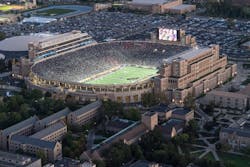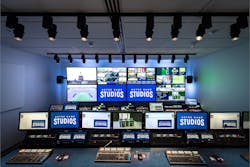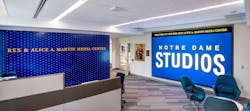Gameday-ready networks
By Joshua Seawell, Sumitomo Electric Lightwave
If your network upgrade and expansion was integral to certain demands, such as a time-sensitive launch of a highly anticipated collegiate sports channel, what would you do? What products would be key to accomplishing this?
In August 2019, this was the question the University of Notre Dame faced. The university needed to upgrade their fiber backbone to support cameras, remote kits and other related gear required to create the sports broadcasts for a fast-approaching launch on ESPN’s ACC Network. A few of Notre Dame’s athletic venues had previously been upgraded, primarily football and basketball. Several of the other collegiate sports venues and setups would be addressed in this project including baseball, lacrosse, soccer, softball, swimming, track and field, and volleyball.
This article explores several of the key products and actions the University of Notre Dame implemented in their recent fiber-optic network upgrade and expansion to address the coming demands. The university faced three primary concerns: space, quality, and costs.
Saving space and time
The 1728-ct UHFC is one of SEL’s slotted core construction cables with a central strength member. This construction yields a flexible product that is not prone to bend preferences and was described by the Notre Dame team as “rugged, yet flexible” and that it “pulls and bends well.”
Because the 1728-ct UHFC cable construction consists of 144x12-ct pliable Freeform Ribbons, more space could be saved through ribbon splicing as opposed to single fiber splicing. Both ribbon splice sleeves and single fiber splice sleeves consume approximately the same amount of space. For example, single fiber splices of a 1728-ct cable would require approximately 78 rack units (RU) of rack space for terminating to connectivity panels due to requiring 72 splice trays holding 24 single-fiber protection sleeves per tray, and the time this would take would be extensive.
Using SEL’s 288-ct x 2RU preterm panels having 24x12-ct ribbon to LC preloaded fanouts only require 12RU of rack space and only 144x12-ct ribbon splices and need only 12 splice trays compared to the alternative of 1728 single fiber splices and 782 splice trays. 288-ct in a 2RU was key to take advantage of the limited available rack space in the Martin Media Center.“High-density enclosures that would keep large amounts of fiber in a smaller rack footprint,” was significant to their decision, notes Jason Hilty, network design professional with the university’s networking and telephony services. Although SEL’s 288ctx2RU preterm panel is a high-density solution and designed for space savings, there are many technician-friendly features built-in, such as the easy-to-use slide-out shelf for patching and access to the splice tray.
Maintaining quality
As with any project, quality is likely the paramount concern. SEL’s Quantum core-alignment fusion splicers and Lynx CustomFit Fusion Splice-On Connectors have been used at Notre Dame prior to this new network project, and Hilty has complimented SEL and noted that Notre Dame has been “extremely happy with Sumitomo’s fusion splicing [Q101-CA] and termination [Lynx2] products.”
Notre Dame’s previous experience with Sumitomo’s high-quality products was key in creating the opportunity to explore SEL’s broader product offerings and solutions, to include UHFC cables, central tube distribution cables, custom cable assemblies, and preterm connectivity panels.
Quality beyond the product
When choosing an end-to-end solution, there is more that goes into the decision than just the product itself. There are many elements to consider, such as the quality of support, resources, and production. SEL’s high-quality standards were the foundation of this project. These high standards were upheld from the start and throughout the project and began with an oversupply of supporting technical and staff resources. “SEL came in as a partner,” said Mauch. “We were surrounded by a ton of support that held our hand throughout the whole process.”
SEL’s high-quality support and product is apparent through the transition to a complete end-to-end ribbon-based product deployment. Notre Dame had previously worked solely with single-fiber fusion splicers. To fully take advantage of SEL’s end-to-end ribbon-based products, using the Quantum ribbon splicer was a must. One of the high-quality and technician-friendly features of SEL’s Quantum series splicers is the commonality in equipment operation and accessories. Through training by SEL’s engineering team coupled with the equipment commonality, installation contractors were able to quickly achieve proficiency with fusion splicing both flat and 12-ct pliable Freeform Ribbon.
No matter how much high-quality support is provided, it will always be insufficient if the quality of the product is lacking. SEL’s fiber-optic products are designed and constructed to achieve the objective level of the quality standards to which they are measured—not just meeting minimum requirements, but rather, the higher objective. For example, the attenuation specification requirement for cable at 1550 nm is ≤0.30 dB/km.
SEL’s UHFC cables surpass the attenuation specification requirements and boast a typical min/max distribution range of 0.183 dB/km to 0.235 dB/km and 94% of the fibers at 0.196 dB/km ±0.01 dB.
Scott Rinehart and other professionals experienced this high-quality product firsthand. “We had to purchase attenuators in order to knock the laser light down as our gear was reporting the light was too bright,” Rinehart said.
Hilty added, “The locations that have been used for an event so far allowed the technicians to finally focus on the broadcast rather than troubleshooting problematic fiber links.”
And Mauch observed: “Great test results with low insertion loss and back reflection [return loss].”
Everyone has a budget
The decrease of time and labor required when fusion splicing 12-ct ribbon compared to fusion splicing single fibers is a key contributor to conserving costs. In this project, the bill rate for fusion splicing is $75/hour. Using this bill rate, we can estimate the savings in labor costs for fusion splicing 12-ct ribbon versus single-fiber splicing. The conservative average fusion splicing time is estimated at 1.5 minutes for single fibers and 2.5 minutes per 12-ct ribbon. These times yield 40 single fiber splices per hour and 24 12-ct ribbon splices per hour. In terms of fiber spliced per hour, this would yield 40 fibers for single fiber splices and 288 fibers for 12-ct ribbon splices. We can now estimate that terminating one end of a 1728-ct UHFC would require 43.2 hours for single-fiber splicing and only 6 hours for 12-ct ribbon splicing. At $75/hour, the single-fiber splicing would cost $3,240 in labor and the 12-ct ribbon splicing would cost $450, which equals a savings of $2,790 per end of the 1728-ct UHFC.
The example reveals a clear correlation between lower costs and projects with higher-fiber-count deployment using a ribbon-based end-to-end solution. The ability to use high-density connectivity solutions, which are also 12-ct-ribbon-based, helps in reducing the total number of components required, which translates to savings in both cost and space.
Any network build places a significant focus on how a product can optimize available space, ensuring quality is achieved comprehensively, and that projects stay within budget. With this project coming to a close, Ric Mauch provides the following advice to others facing their own network-build projects: “Look at different product lines offered, different counts, read testimonials, work with the installer hand-in-hand. Do your homework.”
Joshua Seawell is director of product management at Sumitomo Electric Lightwave.



